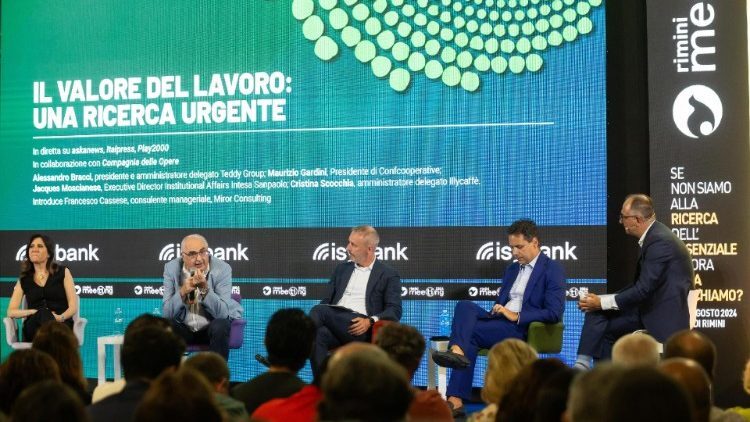“If you think you understand something about the current situation in Jerusalem, it means that they have explained it badly to you,” says Éric-Emmanuel Schmitt, commenting on a famous mural by Banksy, which depicts a peace dove hit by a bullet.
“Jerusalem is tragic,” the French playwright writes in his book adapted into a play directed by Otello Cenci, which was performed on the opening day of the Meeting for Friendship Among Peoples in Rimini.
Jerusalem is tragic, and the events of the past months make this statement even more true.
The stage presents the tangle of a pylon that becomes a staircase and a bridge, and has the unmistakable profile of a cross.
Against the backdrop of stacks of bricked-up, calcined books, white as skeletons, the question “Who are you?” emerges from a constellation of pulsating, living fragments, which offer glimpses of the Holy Land that are different from time to time: walls, graffiti, faces, streets, churches, rubble, fragments of music and songs.
It is a story of transformation and conversion. “WHO ARE YOU? The Jerusalem challenge” was born in the heart of the greatest of contradictions, in the midst of the apparently irrelevant facts of daily life. The reason, writes Schmitt, is that “the cradle of the extraordinary is the trivial.”
On stage are actor Ettore Bassi, the voice, the dance and the grace of the Syrian singer Mirna Kassis, along with Matteo Damele, Filippo Dionigi, Tomas Milner, and a video with Éric-Emmanuel Schmitt himself, who uses his strong French accent to give an even more self-ironic tone to the excerpts of the book he chooses to read.
In one of the funniest scenes of the piece, he even mimics the “gasping of a fish” of a child who, in church, does not know the words of the songs and opens and closes his mouth at random, without making a sound.
The play was born from the author’s biography: Éric-Emmanuel Schmitt, a famous French writer and atheist in life who converted to Christianity, receives an invitation to join a month-long trip to the Holy Land.
In accepting it, the writer intends to keep a diary of this experience, to explain it to himself and to others, and to give himself the reasons for the hope and joy he never felt before.
Places and meetings, between Bethlehem, Nazareth, Galilee, and Jerusalem, become a constant dialogue between doubts and openings to faith.
The result is an unusual book and stage play: a story of conversion from initial distrust to the discovery of the beauty of not being alone in front of the Fifth Gospel of places that, after over two thousand years, are still able to speak. Until the alienating perception of the “physical” presence of Christ at the Holy Sepulchre.
“His gaze,” the French author writes, “has fallen on me, and I can’t fight it. He stares at me, irradiates me, listens to me, passes through me, nothing about me escapes to Him, but at the same time He envelops me with benevolence.”
In Jerusalem, evil shows all its metaphysical nature as a beyond-human enigma, it shows all its incomprehensible nature as a mystery, in History with a capital ‘H’ as in the existences of each human being.”
By Silvia Guidi/ vaticannews






